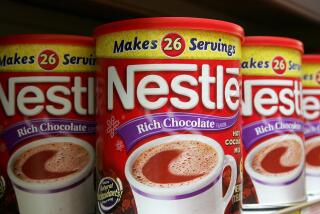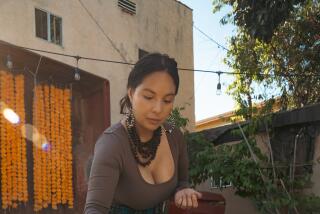Achieving a Sweet Temper
- Share via
When you think about it, chocolate is a miracle. Not just in the magical way it ends arguments, soothes woes and wins love (as well as puts on pounds), but chemically.
That hard, shiny shell on a piece of chocolate candy doesn’t come easily. It is the result of some pretty tricky manipulation. As in some New Age phenomenon, the crystals all need to be lined up.
For the record:
12:00 a.m. Feb. 24, 1999 For the Record
Los Angeles Times Wednesday February 24, 1999 Home Edition Food Part H Page 2 Food Desk 1 inches; 24 words Type of Material: Correction
The correct address for the Web site offering the Sinsation home chocolate tempering machine (“Achieving a Sweet Temper,” Feb. 10) is https://www.iic.com/chandre/.
If you don’t believe it, try melting some chocolate and dipping something into it. More than likely, you’ll end up with something pretty darned ugly.
That’s because the chocolate is out of temper, which is what you probably will be, too. The unfortunate fact is that tempering chocolate is something best left to pastry chefs, candy makers and the truly obsessed.
The problem is that a bar of hard chocolate gets its crisp structure and glossy shine from having the cocoa fat crystals aligned in a particular formation. When the crystals melt, the formation is lost. The chocolate will form crystals and solidify again when it cools. But it’s unlikely that it will go back to that perfect arrangement.
There are four primary crystalline arrangements for fat, and only one (called beta-prime, if you really care) is the correct crystal for tempered chocolate.
In fact, it is true of almost all fats. That’s one reason melted butter that solidifies never looks as smooth and waxy as it did when it came out of the package. (The other is that the water and milk solids have fallen out of emulsion, but that’s another story.) Carefully developed beta-prime crystals are also the secret behind shortening’s glossy, smooth appearance.
Fortunately, chocolate makers have learned how to realign the melted crystals. The process is called tempering. Traditionally, it’s done by what is called the tablier method: Chocolate is melted to 88 to 90 degrees and then two-thirds of it is poured out on a cold table. It is worked back and forth with a spatula until it reaches a temperature of about 81 degrees (this encourages the creation of those darned beta-prime crystals).
At this point, the cooled part is added back to the rest of the melted chocolate and the whole is mixed until all the chocolate cools in lock-step with the beta-prime crystals.
Obviously, this is a process that poses problems for the home cook, who not only doesn’t have a cold table but also probably doesn’t have a thermometer that will measure accurately in those temperature ranges. Even home medical thermometers go down only to 94 degrees.
Really dedicated chocolatiers use a special chocolate thermometer that is accurate at that temperature range (the truly obsessed can buy a home tempering machine like the Sinsation Chocolate Maker, which replicates the tablier process mechanically. It’s only $299, plus shipping and tax at https://www.iic.com).
From time to time, people have offered alternatives. Jacques Torres, pastry chef at Le Cirque and author of the recently published “Dessert Circus at Home” (William Morrow, $28), suggests melting the chocolate in a microwave for 30 seconds on high, then whipping it with an immersion blender. He also says you can “seed” chocolate with beta-prime crystals by adding small pieces of unmelted chocolate to melted chocolate (about 1/4 of the total weight) and beating it with an immersion blender.
Sounds simple. Unfortunately, we could get neither method to work in The Times Test Kitchen.
In her food science column in this month’s Fine Cooking magazine, Shirley Corriher points out that the beta-prime crystals melt at a slightly higher temperature than the other fats in chocolate. She suggests that if you merely melt two-thirds of the chocolate to between 89 and 91 degrees, you can stir the rest back in. As long as the whole doesn’t exceed 92 degrees, your chocolate should be fine. She suggests using a laboratory thermometer. Most home cooks don’t have one of those, either.
The best advice? Forget tempering. In the first place, it is only necessary for pure chocolate that will be used as a coating or decoration. It’s not necessary for chocolate that is cooked with other ingredients.
It’s also easy to disguise un-tempered chocolate, to hide its physical imperfections. This is the approach Bay Area chocolate queen Alice Medrich takes (quite emphatically, in fact) in her book “Cocolat” (Warner Books: 1990, $35).
“The No. 1 mystique that surrounds chocolate has to do with tempering,” she writes. “Everyone wants to temper! Many do not quite understand what tempering is, or why they want to do it, but do it they must. From the dessert-maker’s point of view, I take a radical position: I do not think it is necessary or practical to temper.”
If your heart is set on serving truffles for dinner, go ahead and dip them in melted chocolate, but then just dust them with cocoa powder.
It may lack the magic of perfectly arranged beta-prime crystals, but at least you’ll have your sanity.
Chocolate Truffles
Active Work Time: 30 minutes * Total Preparation Time: 4 hours
This recipe is adapted from Rose Levy Beranbaum’s underappreciated “A Passion for Chocolate” (Morrow: 1989, $22.95), her translation and adaptation of the recipes of the famed French chocolatiers Maurice and Jean-Jacques Bernachon. Beranbaum calls for tempering the chocolate before dipping. Go ahead if you want, but we like it without. The ganache recipe also makes a great frosting and can be adapted in many ways by the addition of a little brandy or other flavorings.
2 3/4 pounds bittersweet chocolate
1 1/4 cups heavy cream
4 cups unsweetened cocoa
2 tablespoons powdered sugar
* Make ganache by breaking 3/4 pound chocolate into small pieces and grinding in food processor. Heat cream just to point that steam begins to appear at edges. With food processor running, add cream to chocolate and blend until chocolate is smooth and creamy. Transfer to bowl and chill until firm, about 2 hours.
* Using small ice cream scoop, melon baller or spoon, scoop out ganache. Dust hands with powdered sugar and roll ganache into balls. Arrange on baking sheet lined with parchment or wax paper and chill until firm.
* Carefully melt 1 3/4 pounds chocolate in microwave on high, heating in 30-second bursts just until melted, about 1 1/2 minutes. Alternatively, melt in double boiler over hot but not simmering water until melted, stirring occasionally. Take special care that no water touches chocolate (dry bottom of pan on towel while stirring).
* Chop remaining 1/4 pound chocolate fine, add to melted chocolate and stir until all chocolate is melted. Keep warm (heating pad set on low is good for this--wrap it in plastic wrap to prevent chocolate stains).
* Place cocoa in 8-inch square baking pan and make 4 (1-inch-deep) troughs in cocoa.
* Using dipping loop or fork (plastic picnic fork with both center tines broken off works well), dip chocolate balls, 1 at a time, in melted chocolate. Turn to coat well. Remove from chocolate, tap against side of pan to remove excess chocolate and place on baking sheet lined with wax paper. Chill well.
When firm, roll truffles in cocoa powder. Spoon cocoa powder over truffle to coat well and remove to another baking sheet lined with parchment or wax paper and refrigerate at least 5 minutes to set chocolate. Remove from refrigerator 30 minutes before serving and store in cool, dry place.
60 truffles. Each truffle: 79 calories; 2 mg sodium; 7 mg cholesterol; 7 grams fat; 6 grams carbohydrates; 2 grams protein; 2.17 grams fiber.
More to Read
Eat your way across L.A.
Get our weekly Tasting Notes newsletter for reviews, news and more.
You may occasionally receive promotional content from the Los Angeles Times.











